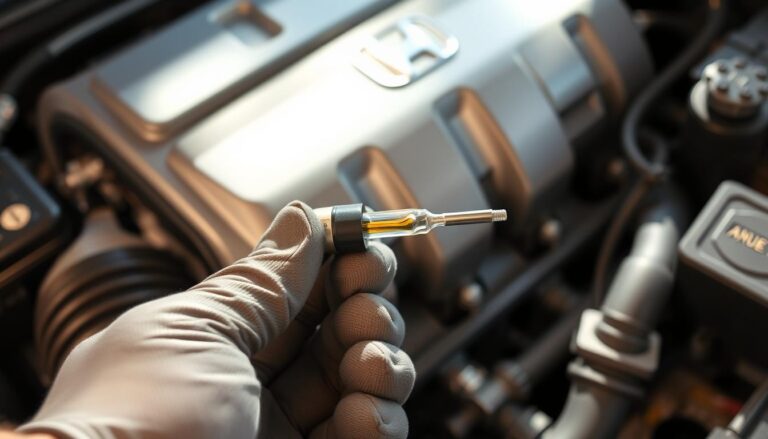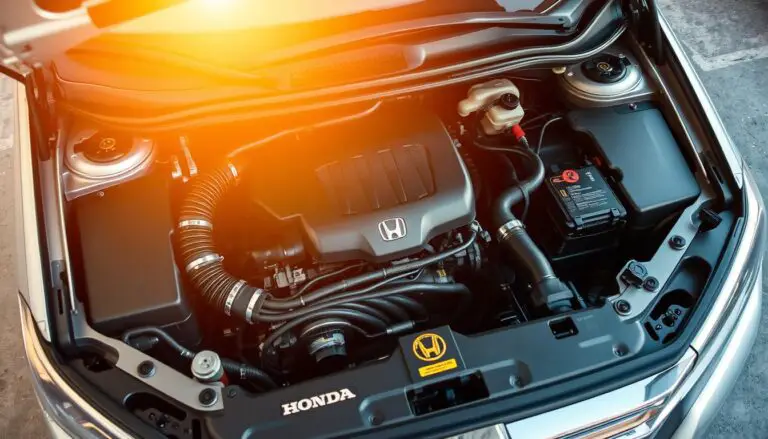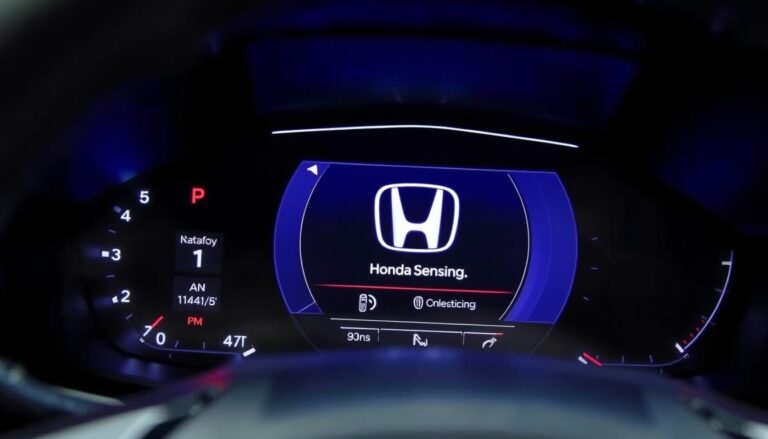Choosing the right engine oil for your Honda Pilot is crucial for maintaining optimal performance and extending your engine’s lifespan. Honda has specific recommendations that vary slightly across model years, and using the wrong type can potentially void your warranty or cause engine damage.
This comprehensive guide covers everything you need to know about Honda Pilot oil specifications, from viscosity grades to oil capacity and maintenance intervals.
Recommended Oil Type for Honda Pilot
Honda officially recommends using Honda Genuine Motor Oil or an equivalent high-quality motor oil that meets the API service requirements. The specific oil type varies slightly depending on your Honda Pilot’s model year, but most models use the following specifications:
| Model Years | Recommended Oil Type | Viscosity Grade | API Classification |
| 2016-2024 | Full Synthetic | 0W-20 | API Service SN or higher |
| 2009-2015 | Full Synthetic or Synthetic Blend | 0W-20, 5W-20 | API Service SN or higher |
| 2003-2008 | Synthetic Blend or Conventional | 5W-20 | API Service SL or higher |
For the latest Honda Pilot models (2016-2024), Honda specifically recommends 0W-20 full synthetic oil. This advanced formulation provides superior protection during cold starts and maintains excellent lubrication at normal operating temperatures.
Honda Pilot Oil Capacity
Knowing the correct oil capacity is just as important as using the right type of oil. Using too little oil can lead to inadequate lubrication, while overfilling can cause foaming and reduced oil pressure. Here’s the oil capacity for different Honda Pilot model years:
| Model Years | Engine | Oil Capacity with Filter Change |
| 2016-2024 | 3.5L V6 | 5.7 quarts (5.4 liters) |
| 2009-2015 | 3.5L V6 | 4.5 quarts (4.3 liters) |
| 2003-2008 | 3.5L V6 | 4.5 quarts (4.3 liters) |
Always check your owner’s manual for the exact specifications for your specific model year and engine configuration. When performing an oil change, it’s best to add slightly less than the full capacity, then check the dipstick and add more as needed to reach the proper level.

Synthetic vs. Conventional Oil for Honda Pilot
While Honda recommends full synthetic oil for newer Pilot models, it’s important to understand the differences between synthetic and conventional oils to make an informed decision, especially for older models.
Synthetic Oil Benefits
- Superior performance in extreme temperatures
- Better engine protection and cleanliness
- Extended oil change intervals (7,500-10,000 miles)
- Improved fuel efficiency
- Better protection during cold starts
- Reduced engine wear over time
Conventional Oil Limitations
- Shorter oil change intervals (3,000-5,000 miles)
- Less effective in extreme temperatures
- More impurities than synthetic oil
- Breaks down faster under high heat
- Less protection during cold starts
- May lead to more sludge buildup over time
For Honda Pilots from 2016 onwards, full synthetic 0W-20 oil is strongly recommended by Honda. For older models (2009-2015), synthetic blend or full synthetic 5W-20 oil provides excellent protection. For the earliest Pilot models (2003-2008), conventional 5W-20 oil is acceptable, though synthetic will still provide better protection.
Honda Pilot Oil Change Intervals
Following the recommended oil change intervals is essential for maintaining your Honda Pilot’s engine health. Modern Honda Pilots are equipped with an Oil Life Monitoring System that calculates when an oil change is needed based on driving conditions and engine operation.
Honda’s Maintenance Minder System
Newer Honda Pilots use the Maintenance Minder system, which displays the remaining oil life as a percentage. When the oil life reaches 15%, the system will alert you that service will be needed soon. When it reaches 0%, it’s time for an oil change.
If your Honda Pilot doesn’t have the Maintenance Minder system or you prefer to follow a fixed schedule, here are the general recommendations:
| Oil Type | Normal Driving Conditions | Severe Driving Conditions |
| Full Synthetic | 7,500-10,000 miles or 1 year | 5,000-7,500 miles or 6 months |
| Synthetic Blend | 5,000-7,500 miles or 6 months | 3,000-5,000 miles or 6 months |
| Conventional | 3,000-5,000 miles or 6 months | 3,000 miles or 3 months |
Severe driving conditions include frequent short trips (less than 5 miles), extreme temperatures, towing, driving on dusty roads, or stop-and-go traffic. If your driving patterns match these conditions, follow the more frequent oil change schedule.

How to Check Oil Level in Your Honda Pilot
Regularly checking your Honda Pilot’s oil level is a simple but important maintenance task that can help prevent engine damage. Here’s a step-by-step guide:
- Park your Honda Pilot on level ground and turn off the engine.
- Wait at least 5-10 minutes for the oil to drain back into the oil pan.
- Open the hood and locate the oil dipstick (usually has a yellow or orange handle).
- Pull out the dipstick, wipe it clean with a lint-free cloth or paper towel.
- Reinsert the dipstick fully, then pull it out again to check the oil level.
- The oil level should be between the two marks or holes on the dipstick.
- Also check the oil’s color – it should be amber or light brown, not black or milky.

If the oil level is below the lower mark, add the recommended oil type in small amounts, checking the level after each addition to avoid overfilling. If you notice the oil is very dark or has a burnt smell, it may be time for an oil change regardless of the mileage.
Honda Pilot Oil Change Procedure
While many Honda Pilot owners prefer to have their oil changed professionally, some enjoy doing it themselves. If you’re a DIY enthusiast, here’s a basic overview of the oil change process:
Required Materials
- 5-6 quarts of the recommended oil (check your specific model)
- Genuine Honda oil filter or equivalent quality filter
- Oil filter wrench
- Drain pan
- Jack and jack stands or ramps
- Wrench for the drain plug
- Funnel
- Gloves and shop rags
Basic Procedure
- Warm up the engine for a few minutes to lower oil viscosity
- Safely raise and secure the vehicle
- Remove the drain plug and drain the old oil
- Remove and replace the oil filter
- Reinstall the drain plug with a new washer
- Add new oil through the fill hole (about 5.7 quarts for newer models)
- Check the oil level with the dipstick
- Reset the maintenance minder system
Safety Warning
Always ensure your vehicle is securely supported before working underneath it. Never rely solely on a jack. Use proper jack stands or ramps rated for your vehicle’s weight. Hot oil can cause severe burns, so let the engine cool down before beginning the oil change.
Prefer Professional Service?
If you’re not comfortable changing your Honda Pilot’s oil yourself, professional service ensures the job is done right with the correct oil type and filter. Many Honda dealerships and service centers offer competitive pricing on oil change services.
Consequences of Using the Wrong Oil in Your Honda Pilot
Using incorrect oil in your Honda Pilot can lead to various problems, from minor performance issues to serious engine damage. Here’s what could happen if you use the wrong oil:
Potential Problems from Using Incorrect Oil
- Reduced Fuel Economy: The wrong viscosity can increase friction and reduce efficiency.
- Poor Engine Performance: Incorrect oil may not provide proper lubrication, leading to sluggish performance.
- Accelerated Engine Wear: Inadequate protection can cause premature wear on engine components.
- Sludge Buildup: Lower quality oils may break down faster, creating harmful deposits.
- Overheating: Improper oil can lead to increased operating temperatures.
- Warranty Issues: Using non-recommended oil may void your vehicle’s warranty.

Always refer to your Honda Pilot’s owner’s manual for the manufacturer’s oil recommendations. If you’re unsure, consult with a certified Honda technician who can provide guidance specific to your vehicle’s model year and condition.
Seasonal Oil Considerations for Honda Pilot
While modern synthetic oils like 0W-20 perform well in all seasons, understanding how temperature affects your Honda Pilot’s oil can help you make informed maintenance decisions.
Cold Weather Performance
The first number in the oil viscosity rating (e.g., “0W” in 0W-20) indicates how well the oil flows in cold temperatures. Lower numbers mean better cold-start protection.
- 0W-20 provides excellent cold-start protection down to -40°F
- 5W-20 offers good protection down to about -22°F
- 10W-30 is suitable down to about -4°F
For Honda Pilots in extremely cold climates, 0W-20 synthetic oil is ideal as it flows quickly to critical engine parts during cold starts.
Hot Weather Performance
The second number in the viscosity rating (e.g., “20” in 0W-20) indicates the oil’s thickness at normal operating temperature. Higher numbers provide better protection in hot conditions.
- 0W-20 maintains adequate protection at high temperatures for Honda Pilots
- Modern synthetic oils resist breakdown even in extreme heat
- Check oil levels more frequently during hot weather
Honda’s recommended 0W-20 synthetic oil is formulated to provide excellent protection even in hot climates and during demanding driving conditions.

Choosing the Right Oil Filter for Your Honda Pilot
The oil filter is just as important as the oil itself. It removes contaminants and particles that could damage your engine. Honda recommends using Genuine Honda oil filters, which are specifically designed for your Pilot’s engine.

Genuine Honda Filter
Designed specifically for Honda engines with precise filtration and flow characteristics.
Recommended

Premium Aftermarket
High-quality alternatives from brands like Bosch, WIX, or NAPA that meet or exceed OEM specifications.
Good Alternative

Economy Filters
Budget options that may not offer the same filtration quality or longevity as premium filters.
Budget Option
When selecting an oil filter, consider that the filter should be changed with every oil change. Using a high-quality filter helps ensure that your engine remains clean and protected between oil changes.
Complete Oil Change Kit
For convenience, consider purchasing a complete oil change kit that includes the recommended synthetic oil and a genuine Honda filter for your specific Pilot model year.
Should You Use Oil Additives in Your Honda Pilot?
With many aftermarket oil additives promising improved performance, reduced consumption, or engine restoration, Honda Pilot owners often wonder if these products are beneficial or necessary.
Honda’s Official Position
Honda does not recommend using aftermarket oil additives in their vehicles. The company states that their recommended oils already contain the optimal additive package for Honda engines, and additional additives may disrupt this carefully engineered balance.
Modern synthetic oils like the 0W-20 recommended for Honda Pilots already contain a sophisticated blend of additives that provide:
- Anti-wear protection
- Detergents to keep the engine clean
- Dispersants to prevent sludge formation
- Anti-oxidants to prevent oil breakdown
- Friction modifiers for fuel efficiency
- Anti-foaming agents
If you’re experiencing issues like oil consumption, unusual noises, or poor performance, it’s better to address the underlying mechanical problem rather than trying to mask it with additives. Consult with a certified Honda technician for proper diagnosis and repair.
Frequently Asked Questions About Honda Pilot Oil
Can I use 5W-20 instead of 0W-20 in my newer Honda Pilot?
While 5W-20 is similar to 0W-20 and may work in emergency situations, Honda specifically recommends 0W-20 for newer Pilots (2016 and newer). The “0W” provides better cold-start protection and can improve fuel efficiency. For optimal engine protection and to maintain your warranty, it’s best to use the recommended 0W-20 synthetic oil.
How do I reset the oil life indicator on my Honda Pilot?
To reset the oil life indicator on most Honda Pilots:
- Turn the ignition to ON (don’t start the engine)
- Press the SELECT/RESET knob repeatedly until the engine oil life indicator appears
- Press and hold the SELECT/RESET knob for about 10 seconds until the indicator blinks
- Press and hold the knob again until the oil life resets to 100%
For newer models with a touchscreen, the process may vary. Consult your owner’s manual for specific instructions.
Is synthetic oil worth the extra cost for my Honda Pilot?
Yes, synthetic oil offers significant benefits that justify the higher cost, especially for Honda Pilots. These benefits include better protection during cold starts, improved high-temperature stability, longer change intervals, better engine cleanliness, and potentially improved fuel economy. For newer Pilots that specifically require 0W-20 synthetic oil, using conventional oil could potentially void your warranty and lead to engine issues.
Can I mix different brands of oil in my Honda Pilot?
Yes, you can mix different brands of oil as long as they have the same viscosity rating (e.g., 0W-20) and meet the same API service classification. However, it’s generally best to stick with one brand and formulation for consistent performance. If you need to top off your oil between changes and don’t have the same brand available, using a different brand of the correct specification is better than running low on oil.
Conclusion: Keeping Your Honda Pilot Running Smoothly
Using the correct oil type and maintaining proper oil change intervals are among the most important factors in ensuring your Honda Pilot’s longevity and performance. For most modern Honda Pilots (2016-2024), Honda recommends 0W-20 full synthetic oil with API service classification of SN or higher.
Regular oil changes, along with using the recommended oil type and filter, will help protect your engine from wear, maintain fuel efficiency, and prevent costly repairs down the road. Whether you choose to change your oil yourself or have it done professionally, following Honda’s guidelines is the best way to keep your Pilot running smoothly for years to come.




